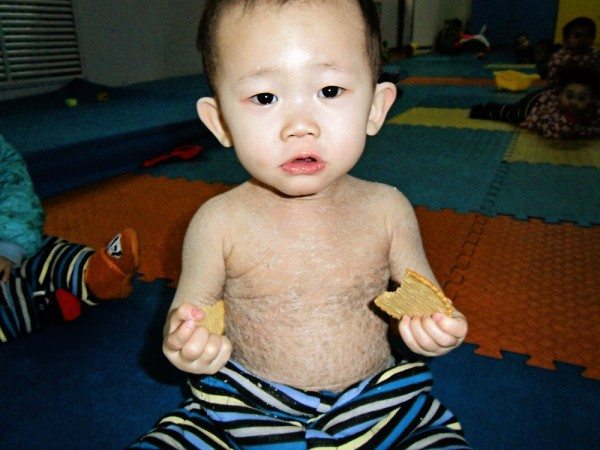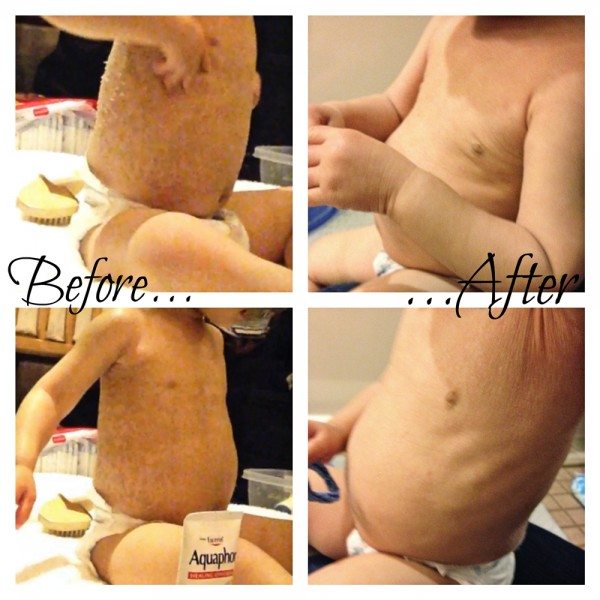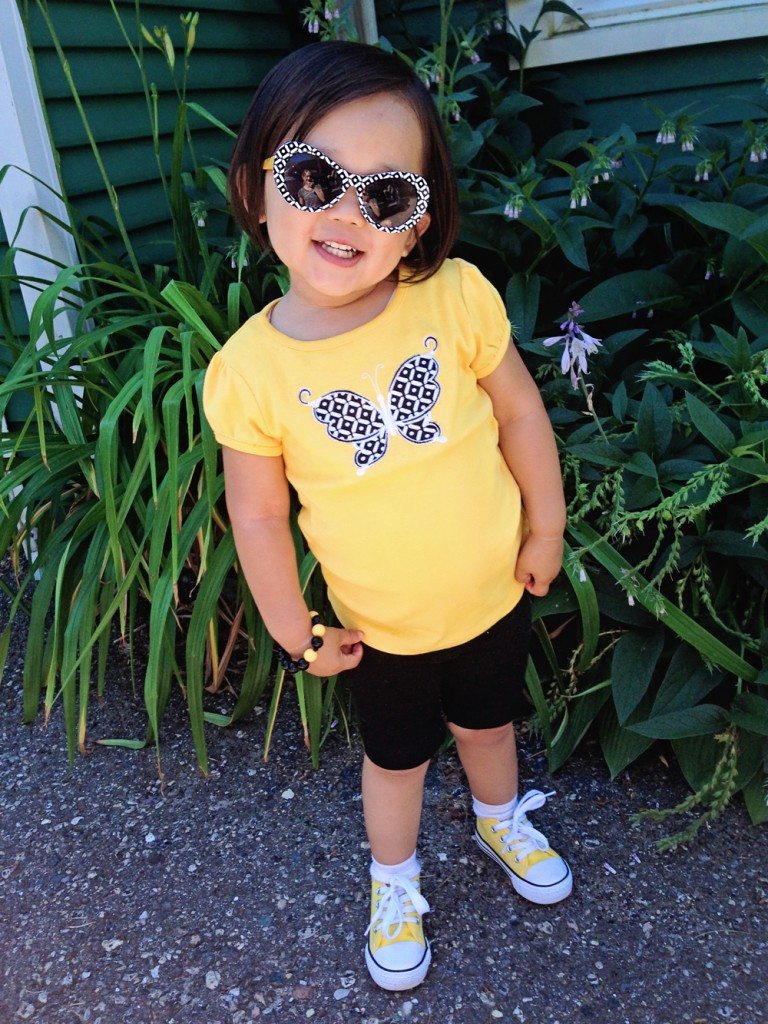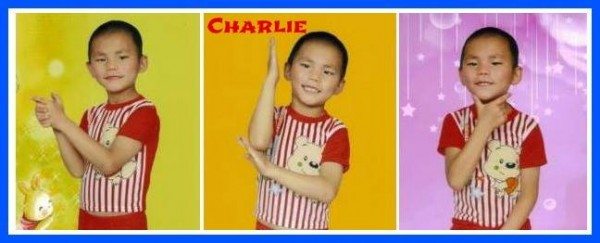We had been waiting months for “The Call” from our adoption agency. Our homestudy was complete and our dossier sent to China. We were waiting, on edge, to be matched with our daughter. And when the call finally came, I missed it. My phone was in silent mode in my purse and by the time I got the voicemail with the vague, “Please give us a call at your earliest convenience…” message, office hours were over.
I did not sleep that night. I knew it must be our match! I kept my eye on the clock all morning and the minute the office was open I called our agency. It was indeed a match!
She said, “We have a referral for you! She is a 21-month old girl with Ichthyosis. Would you like me to send you her file?”
I think my answer was something like, “YES! But can you repeat the special need?”
“Ick-thee-O-sis…. it was on your medical conditions check list?”
“Oh, yes, of course. Thank you!” (I had no idea which one that was, but I knew we had researched each special need and checked the ones we thought we could provide care for; I just needed to refresh my memory!)
The email arrived quickly and I saw the most adorable face of a darling little girl. We also saw photos of some very scaly, flaky skin, a bad case of dandruff, and some waxy little fingers and toes with white lines like tiny cracks on the surface. My husband and I spent the next several hours learning more about Ichthyosis. A genetic skin condition… no cure… causes scaly or flaky dry skin… requires frequent moisturizing… can cause tightening of skin or cracking… can cause overheating due to thick skin covering sweat glands… not contagious… does not generally affect overall health, etc.
It did not take us long to decide that this need was rather manageable. As one with medical phobias (needles = fainting for me), I was relieved that this didn’t seem to be a very “medical” need; as in, no surgeries, no medications, just daily care at home, as well as the possibility of social or psychological issue depending on how visible it is. We consulted with a local Pediatric Dermatologist for good measure, and then submitted our Letter of Intent to adopt our daughter!
She has now been home almost a year and we are so blessed. I can’t imagine life without her. A wonderful blog post has previously been written about Ichthyosis on NHBO, which explains more about this condition. So I am going to focus on the daily care involved, and some things we have been learning and figuring out about our daughter’s skin. We hope to encourage families to add this special need to their list of medical conditions that they would consider.
There are many different types of Ichthyosis, but for the most part the treatment is generally the same. There is a range of severity, as well as variations on which areas of the body are most affected. Our daughter’s case ranges from mild to moderate, depending on the weather and exposure. Her scalp, hairline, back, torso, hands, and feet are most affected, while her arms, legs, and face remain less affected.
When we first saw the photos of our girl’s back and torso covered with scaly, flaky skin, I often wondered what it would feel like. I expected it to be coarse and calloused. I doubted it would ever feel like soft, smooth baby skin. I was mistaken on both accounts. We found that her skin was soft and peeling much like a sunburn. And it was messy. And a bit itchy. Every time we changed her clothes during our time in China, flakes would fly everywhere and she would itch across her stomach.
We bathed her in lukewarm water and used a washcloth to gently exfoliate the dead skin away. We applied ointment on the areas of driest skin, and lotion on the rest of her skin. Within 2-3 weeks she had transformed. You could hardly even tell she had a skin condition.
The ointment, called Aquaphor, has worked wonders for her. The best news is that children with Ichthyosis can get a free lifetime supply of this product. Beiersdorf, the makers of Aquaphor, will send a case of their product (12 huge jars) if you have your doctor fax them a note with your child’s diagnosis and treatment plan. When your supply runs out you simply request another. This is such a generous offer from them and has benefited so many people affected by this condition.
The downside of Aquaphor is that it’s quite heavy and greasy. I only use it on her driest areas, which are her torso, back, and feet. I make sure she always wears an undershirt to keep it from soaking into her clothes. The undershirts start to feel slightly heavy and I can tell it’s not washing out very well. Perhaps I should try adding vinegar or dish soap to the white laundry, but at this point she’s growing so fast that by the time one set is getting soiled (6 months or so) she’s ready for the next size and we get a fresh new set of undershirts.
I apply the Aquaphor at least 3 times a day, or whenever I notice her skin is feeling more dry and less smooth. I use a regular hand or body lotion on her arms, legs, and face and they tend to stay pretty moisturized if I apply it in the morning and at bedtime. In the winter her scalp is a struggle with the worst dandruff. (Since we can’t use Aquaphor on her head – it would result in greasy hair!!) Selsun Blue helps, as well as hair conditioner with a few drops of Tea Tree Oil added. We also use a very fine-toothed comb (a lice comb, actually) to comb the flakes out.
In the summer her scalp is much better, but summertime also brings a new set of problems. Careful sun exposure is fine, even good for her, but on the days we go to the beach or pool for an extended period of time she comes away with red skin that looks similar to a sunburn. It clears up within 2-3 days. I had a nosy old man at the beach inform me that my daughter was burning and I needed to put sunblock on her. She was not burning, we had just arrived, but the day before we had used waterproof sunblock and she woke up with an allergic reaction. We had to find a gentle, natural, non-waterproof kind. She tans quite well, but her tanned skin starts to peel and is very patchy-looking for a few weeks. Not a big deal, aside from a few curious comments from other children.
Additionally, if you live in a dry climate or have a dry season I would recommend installing a whole-house humidifier, or using a smaller one in their room. We had one installed for about $375 and it was worth it. In fact, our whole family enjoyed the benefits of having some moisture in the air last winter!
Finally, I’ll mention her hands and feet. Because the skin builds up before it sheds she tends to get a thick, waxy-looking layer on her finger and toes. Sometimes it has tiny brownish/tanned-looking scales, or little white lines like cracks on the surface. Her skin has never dried enough to crack deep or bleed, only the top layers are affected. In the summer when she wears sandals or is barefoot a lot, the bottom of her feet will start to peel. She likes to sit and peel the dead skin off (whatever, it doesn’t hurt her… but I try not to let her walk around showing people how big of a piece she got. LOL) To help with that, I put Aquaphor on her feet before naptime and bedtime and cover them with socks. They just need to soak in some moisture again.
It all might sound a little overwhelming, but it’s just a part of our daily routine that I hardly notice anymore. Her “special need” might as well be summed up as “dry skin”. We can handle that! And keep in mind that I’ve shared her worst-case scenarios. Her skin is very smooth and easy to maintain about 80% of the time!
Two side notes about Ichthyosis kids’ files and referrals:
1. The photos you see in a child’s profile or update will probably be the worst their skin condition will ever be. The orphanage does their best to care for them, but unless they are in a foster home it’s doubtful that they are receiving enough individual care to keep the skin moisturized. Don’t fear that it will “spread” or “get worse”, because that’s not likely. It will get SO much better with your help!
2. If you get a referral for a child who has a different type of Ichthyosis, you may have more to consider regarding the social aspect. For example, some children will have noticeably tight skin on their face, or will have a more shiny or red look to their skin. Be sure you are prepared to deal with curious children, ignorant adults, questions, or stares (in addition to the ones you’ll get as a multicultural adoptive family, of course!).
For more information about Ichthyosis, check out the following links:
• Read inspiring stories from parents of Ichthyosis kids, or adults and their story of living with it here.
• Find answers to common questions and myths about Ichthyosis here.
• Helpful tips and products recommend for treatment can be found here.
– guest Post by Nikki Schuler (read about her previous – and current! – adoption journey here)
……….
Waiting Child Highlight
Twelve year old Charlie is a handsome older boy with congenital ichthyosis. He has a $3,000 grant with Madison Adoption Associates. He is introverted, easygoing and well behaved. He communicates with people in a normal way. He knows right and wrong. He knows directions, colors, shapes, sizes. He knows and can write simple characters. He can write his own name. He knows simple calculation.
He is hard working and very clean. He washes his own clothing and cleans his room. He likes playing with basketball, soccer, singing, dancing and painting. He is modest and can share. He gets along well with other kids.
Fill out this form for more information on adopting Charlie.
……….





























Leave a Reply